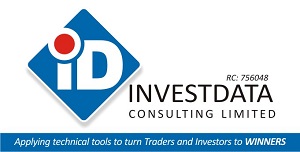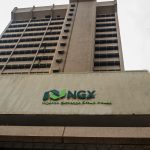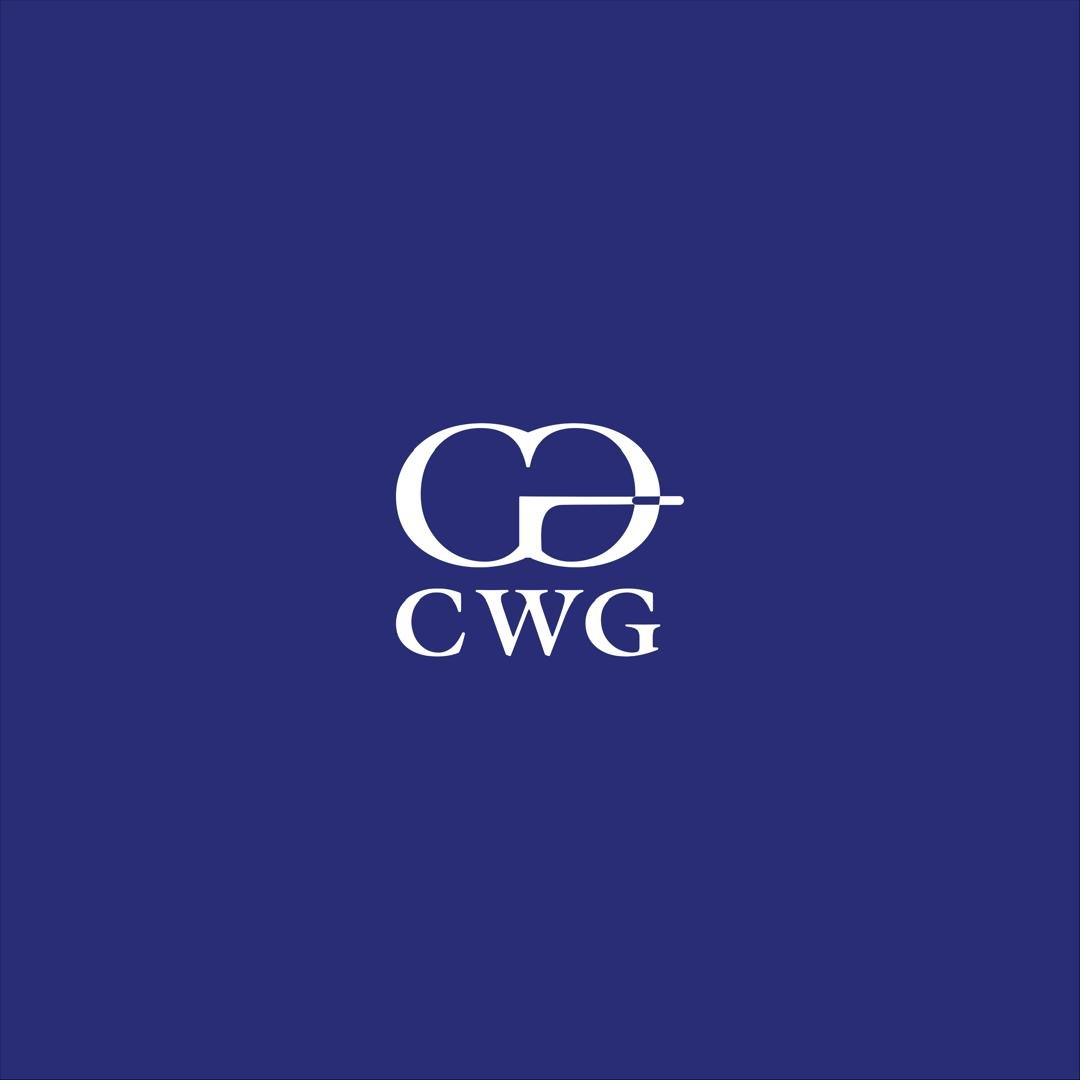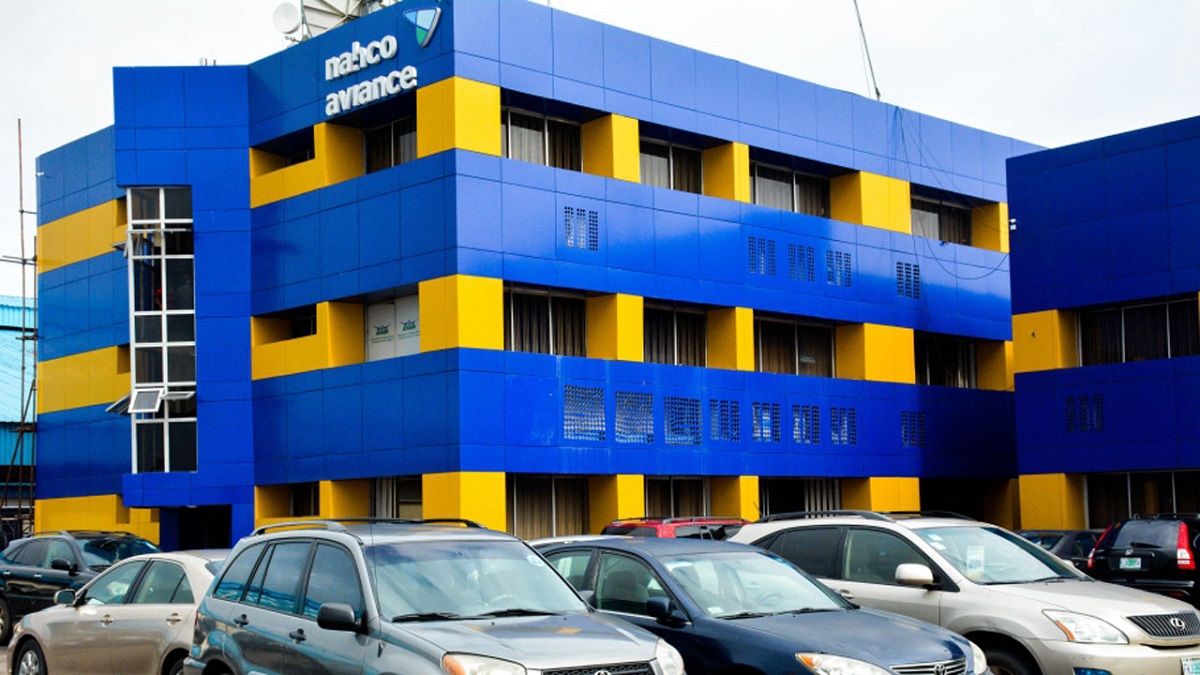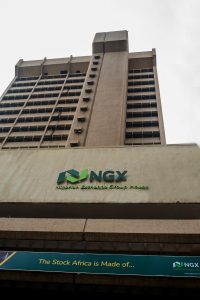
Quarter Under Preview: Third Year
Current Share Price: N81.00
Latest Dividend: N1.05
Estimated Beta Value: 0.35x
Estimated Intrinsic Value: N41.47
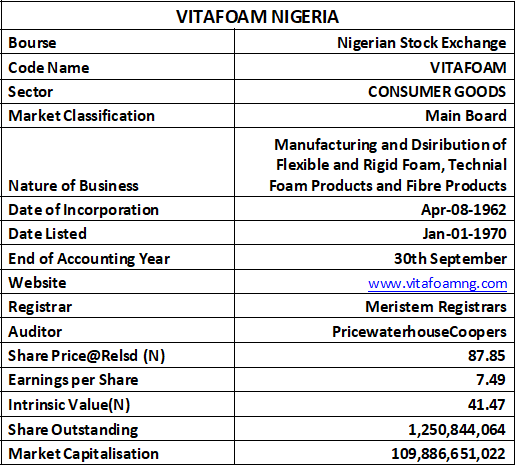
The Company
Vitafoam Nigeria Plc is a Nigeria-based manufacturer of flexible, reconstituted, and rigid foam products. It has two segments – Foam products and Furniture/other products. The foam products comprise flexible and rigid foam based products as well as memory foams. The Furniture and other products include wood and metal based furniture and fibers among others. Its products include Inner Core Spring Mattresses, Regular Flexible Foams, Fiber-Based and Allied Products, Rigid Foam, Visco-elastic (Memory) Foam, and Furniture Products.
Financials For 9-Month Ended 30th September, 2025
At the end of the first nine months of 2025, the management of Vitafoam reported a Turnover of N84.871 billion, as against the N60.48 billion in the corresponding period of 2024. The said figure represented a 40.31% growth. Similarly, the Direct Cost of Sales grew by 42.76% to N56.02 billion, compared to N39.24 billion in the same quarter of the previous year.
Thus, Operating Profit for the nine months looked good at N18.48 billion from the previous N806.97 million. The company seems to have cut down on its Operating Expenses as the figure dropped appreciably to N11.28 billion when compared to the previous N20.88 billion. Profit Before Tax, therefore, stood at N13.82 billion while the Total Profit reported for the Period after considering the Tax element leaped to N9.12 billion, compared to the negative earnings posted in the corresponding quarter of 2024. See below for details:
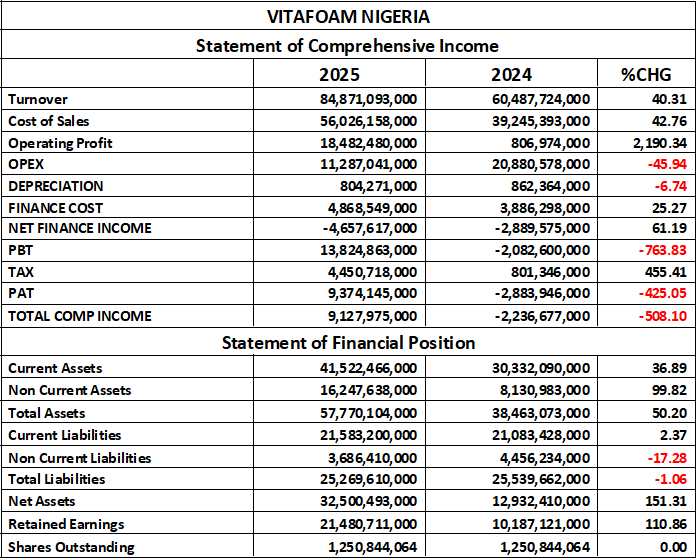
Current Assets at the end of the quarter is estimated at N41.52 billion, higher than the N30.33 billion in the comparable quarter of last year. Non-Current Assets stood at N16.24 billion almost double of the previous quarter value. Thus, Total Assets is valued at N57.77 billion from N38.46 billion. Confirming the preservative business approach adopted during the year, Current Liabilities is almost at par, as it is currently valued at N21.58 billion against N21.08 billion, while Non-Current Liabilities dropped by 17.28% to stand at N3.68 billion. Thus, Total Liabilities at the end of the period is estimated at N25.26 billion as against the previously reported N25.53 billion. Net Assets improved largely by 151.31% to N32.50 billion compared to N12.93 billion. See the above table for details:

Financial Strength
Debt Ratio improved to 43.74% from 66.40%, revealing how much of the company’s assets are financed by debt, meaning that the company has reduced its reliance on borrowed funds to finance its assets. The lower ratio indicates stronger solvency, lower financial risk, and better control of liabilities. This is positive sign showing that the company is now less leveraged and more financially stable.
Total Debt to Equity Ratio, therefore, dropped sharply from 197.5% to 77.7% in the current quarter. This means that for every N1 of equity, the company now has only N0.78 of debt, compared to N1.97 in the previous quarter. This reflects a substantial improvement in leverage and financial health. Consequently, we can safely conclude that the company’s capital structure is now more balanced and sustainable.
Equity Ratio on the other hand moved up to 56.25% from 33.62%, this increase shows that owners now fund more of the company’s assets evidence of a stronger capital structure, greater financial independence, and reduced dependence on debt. This is also a positive sign showing that investors’ equity forms a larger cushion against losses.
We must however caution that excessive low leverage might mean the firm is not fully utilizing the benefits of debt financing opportunities such as tax shields, or leverage-driven growth. But given the previous high debt levels, we can still safely conclude that this shift is a healthy correction.
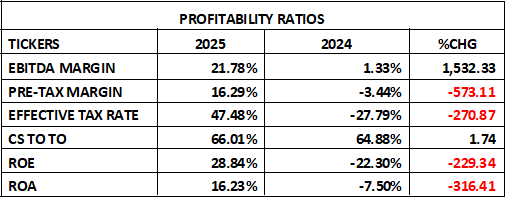
Profitability Ratios
EBITDA Margin galloped to 21.78% from 1.33%, showing a strong recovery in operating efficiency. Vitafoam Nigeria is now generating N0.22 of operating profit from every N1 of sale, compared to only N0.01 generated in the same period of 2024. This indicates better cost control, higher sales efficiency, or improved pricing strategy, a sign of Operational Turnaround and enhanced profitability from core business activities.
Cost of Sales slightly increased from 64.88% to 66.01%, this means gross profit margin has narrowed slightly from 35.12% to 33.99%. Despite this, the strong rise in EBITDA margin means operating expenses were managed effectively, offsetting the minor rise in production cost. It is necessary to observe that production or input costs are slightly rising, management should, therefore, monitor cost efficiency closely.
Return on Equity moved from a negative position of -22.3% to a healthy profit of 28.84%, which suggests that shareholders’ funds are now being used efficiently to generate profit. It also reflects strong profitability recovery, improved earnings, and enhanced investor value. Thus, equity is now generating solid returns after previous losses.
The Return on Assets moved from the negative 7.5% to positive 16.23% showing a turnaround in asset utilization. The company is now generating N0.16 profit from every N1 of asset, a strong performance improvement. We can now safely say, Vitafoam Nigeria’s assets are now productive and profitable.
The company’s recovery as revealed by the return to strong profit is closely tied to its improved capital structure. With the reduction in debt level and stronger equity position, there has been a cut in interest costs, stabilized operations and boosted returns. The outcome is a financially stronger, more profitable and sustainable business.

EFFICIENCY RATIOS
Operating Expenses to Turnover Ratio dropped significantly from 34.52% to 13.30% in the period under review. This is a major improvement that shows strong cost efficiency, as management has effectively controlled overheads and improved productivity. This improvement directly contributed to the earlier observed rise in EBITDA Margin. It is a sign that the company has greatly improved its cost discipline, leading to higher operational profitability. Nevertheless, management must ensure the reduction doesn’t affect service quality or future growth. There is also need to avoid under-investment in key areas as may negatively impact the business going forward.
Turnover to Total Assets Ratio slightly declined from 157.26% to 146.91%. This drop suggests slower assets utilization, or possible expansion in total assets that has not translated yet into proportional sales. Please understand that, while efficiency here dipped slightly, it is not alarming because profitability (EBITDA, ROA, & ROE) improved sharply, meaning the company is now more profitable per unit of sales, even if sales efficiency fell slightly.

The Amount Earned per unit of shares moved from the negative side to N7.49, indicating a strong earnings recovery, while confirming earlier findings of improved ROE, EBITDA margin and Operating Efficiency. The company is now generating positive returns for shareholders after the loss of the corresponding quarter. PE/Ratio shows investors are now valuing the company shares at approximately 11.7 times its annual earnings. This is a reasonable and healthy valuation, suggesting moderate investor confidence and expectation of steady earnings growth. The said earnings yielded 8.53%, compared to the negative yield of the similar quarter of 2024. This attractive yield shows a healthy return.
Book Value increased from N10.34 to N25.98, indicating substantial growth in shareholders equity, while indicating that the company has strengthened its balance sheet, retained more earnings, or improved asset quality.
Projecting Full Year’s Earnings (EPS)
From the published quarterly numbers, first quarter EPS is estimated at N2.38, the second quarter N5.36 while the third quarter is estimated at N7.49. While trying as much as possible to be realistic in our projection, we have assumed that growth will continue slowly as profit stabilizes. Therefore, we expect a moderate growth of 20 – 30% over the third quarter earnings. On strength of this, we project the fourth quarter EPS at N9.36 each.
Valuation
While trying to estimate the Intrinsic value for each unit of Vitafoam Share, we used two methods: The Gordon Growth Model (DDM), which suggested a very low intrinsic value of N6.38 per share. We also used the Earnings Based Residual Income Model which gave us N41.47 each. Because the company’s EPS and ROE are strong, while dividend payout (last dividend is N1.05) is conservative, the residual income model gives a more realistic valuation for a growth stock. As such, it is safe to conclude that the true Intrinsic Value of Vitafoam Nigeria is N41.47 each. Nevertheless, since this stock is selling at almost double of its estimated Intrinsic Value, we urge caution around the stock for now.
